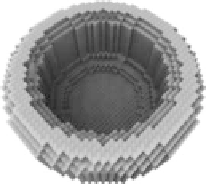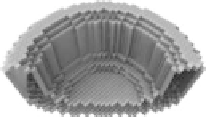Image Processing Reference
In-Depth Information
(a) A double-layered
irreducible digital curve.
(b) A thick-walled disconnected
digital surface of revolution.
(c) Missing voxels.
(d) A thick-walled irreducible
digital surface of revolution.
(e) A part of the irreducible
digital surface.
FIGURE 7.15: A thick- and hollow-walled irreducible digital surface of rev-
olution. (See color insert.)
Reprinted from
International Journal of Arts and Technology
,
4
: 196-215, G. Kumar et al., Copyright 2011, with
permission from Inderscience Publishers.
by approximating the circle of radius maxDis with a regular polygon having
side length, d = 1. Thus,
π
numSides = round
.
(7.8)
d
2maxDis
sin
−
1
Now, for each point on G, we approximate the circle of revolution with a
regular polygon with numSides sides. For every pair of adjacent points on G,
we join the corresponding vertices of the approximate polygon corresponding
to the circle of revolution. In this way, we obtain a simple quad-decomposition
of the surface of revolution. For a faster rendering, we can approximate the
digital generatrix/B-spline by selecting alternate points (or 1 in every h > 1).
Then the value of d has to be changed to h. In our experiments, we have taken
h = 4.
In this way, the digital continuity of the original image is easily main-
tained on the texture map, with satisfactory results. Note that we resorted to
floating-point computations because of the artistic finish on the digital pot-





















